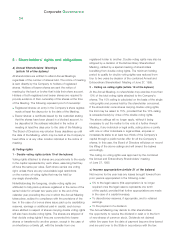APC 2002 Annual Report Download - page 45
Download and view the complete annual report
Please find page 45 of the 2002 APC annual report below. You can navigate through the pages in the report by either clicking on the pages listed below, or by using the keyword search tool below to find specific information within the annual report.
Business review
44
Net effect of exchange rate and other changes
Substantially all subsidiaries are consolidated on the basis
of financial statements established in their local currencies,
with the exception of those operating in hyperinflationary
economies. The consolidated financial statements, however,
are presented in euros. Balance sheet items of non-euroland
subsidiaries are translated at official year-end exchange rates
while income statement amounts and cash flow items are
translated at weighted-average annual exchange rates.
In the cash flow statement, cash and cash equivalents at
the end of the year are originally translated at the official year-
end exchange rate. A difference arises when they are re-
translated using the average annual exchange rate. In 2002,
the net effect of exchange rate and other changes came
to 2.7 million, versus 14.1 million in 2001 and 25.9 million
in 2000.
Seasonal variations
Schneider Electric’s sales are affected by seasonal variations,
as the construction business is busier in the summer than in
the winter. Quite logically, this affects demand for electrical
products used in this market. The high season for construction
runs from June to October in North America and the rest of
Europe, but is concentrated in June and July in France.
Impact of inflation and price changes
Business is affected by inflation in certain markets,
but the majority of sales, expenses and income are generated
in countries that have enjoyed low inflation rates over the last
several years.
In hyperinflationary environments, the Company can generally
increase selling prices to offset the impact of higher costs
and thereby generate sufficient cash flow to preserve its
productive capacity.
Short-term interest rate exposure
Our risk policy for short-term rate exposure and cash is
to minimize the cost of borrowing, depending on market
conditions. The Company uses swaps to hedge its commercial
paper exposure.
Interest rate risk on long-term debt
At December 31, 2002, financial debt mainly comprised
fixed-rate borrowings and variable-rate borrowings swapped
for fixed-rate debt. Since most of our debt is essentially
fixed-rate, we are exposed to the risk of a decline in interest
rates.
Depending on the conditions of the financial market,
we determine whether to use derivative instruments to hedge
our interest rate exposure in order to minimize the cost of
borrowing. The choice of issuing fixed or variable rate debt
depends on (i) the overall exposure of the Group, and (ii)
overall market conditions, as we tend to issue fixed rate debt
when interest rates are low.
Foreign currency risk
We have international operations and thus we are exposed
to foreign exchange risk arising from various currency
combinations. The exposure to exchange rate fluctuations
concerns some twenty currencies, with the US dollar and the
British pound now the most significant sources of currency
risk.
Most of our operations around the world are carried out
by subsidiaries that trade primarily in their home country.
With the exception of some operating subsidiaries domiciled
in highly inflationary environments, the functional currency of
each of our companies is considered to be its local currency.
We are thus exposed to the currency risk associated with
translating our functional currency financial statements into our
reporting currency, the euro.
In addition, we have foreign exchange transaction exposures
related to our global operating activities in currencies other
than the functional currency in which our entities operate.
This exposure arises from intercompany transactions between
“global plants” or “international distribution centers” and local
subsidiaries, as well as from direct export sales and
purchases.
It is our policy to identify and manage transactional foreign
exchange exposure to reduce risk. Our subsidiaries are
responsible for identifying accounts receivable and accounts
payable denominated in currencies other than their local
currency and entering into intercompany hedge contracts with
the Corporate Treasury Center. The intercompany hedge
contracts have the effect of transferring the currency risk from
























